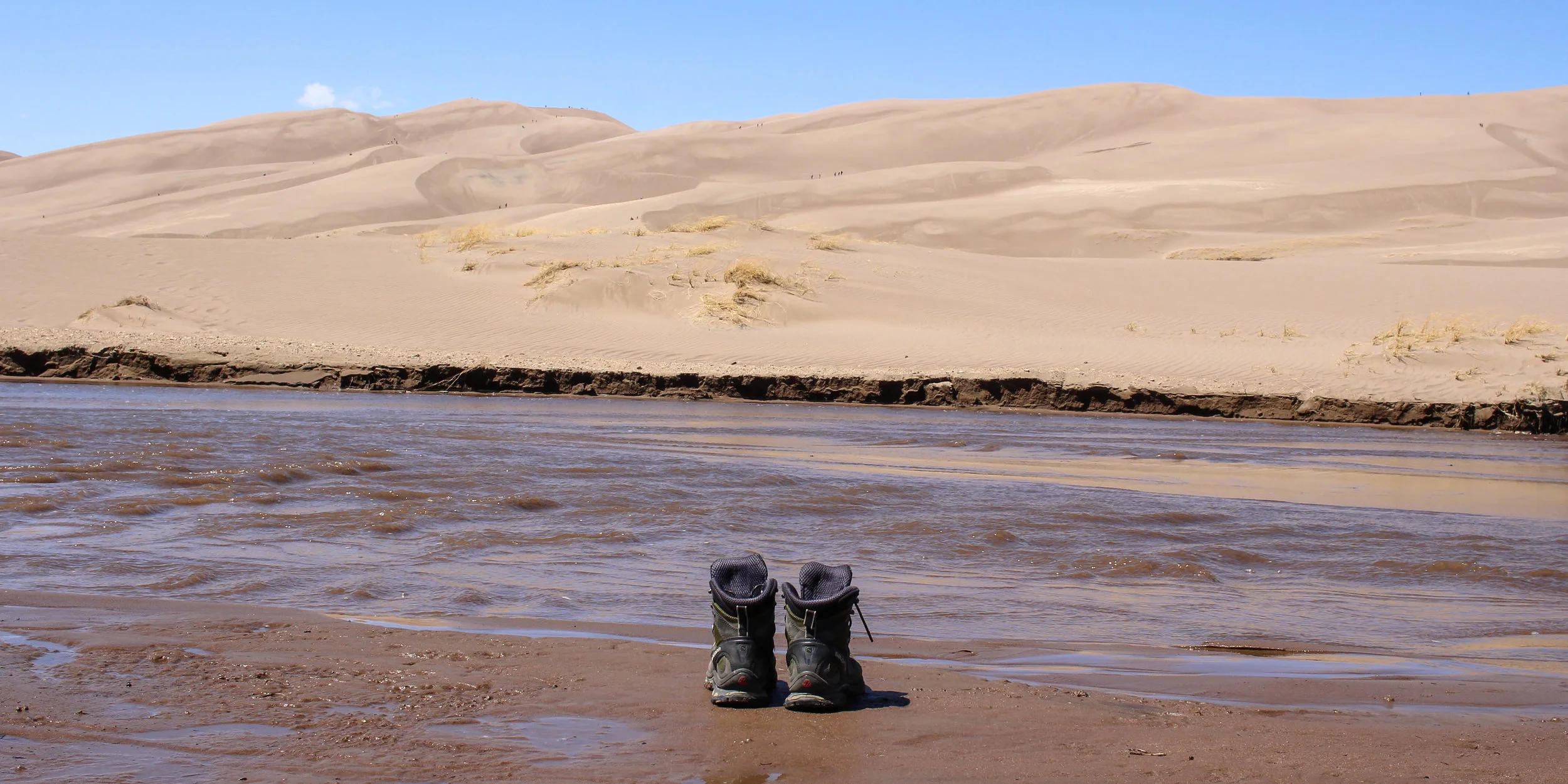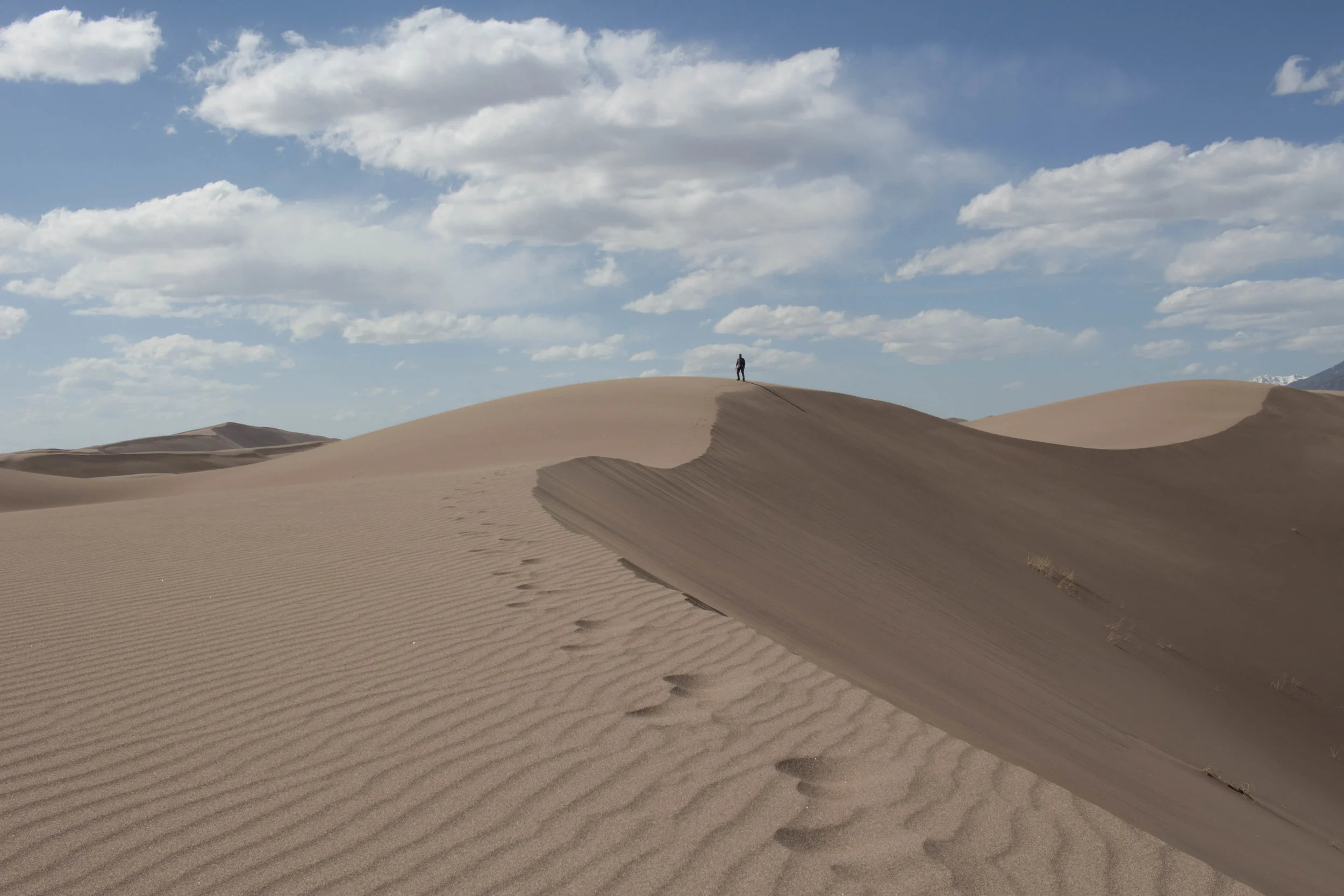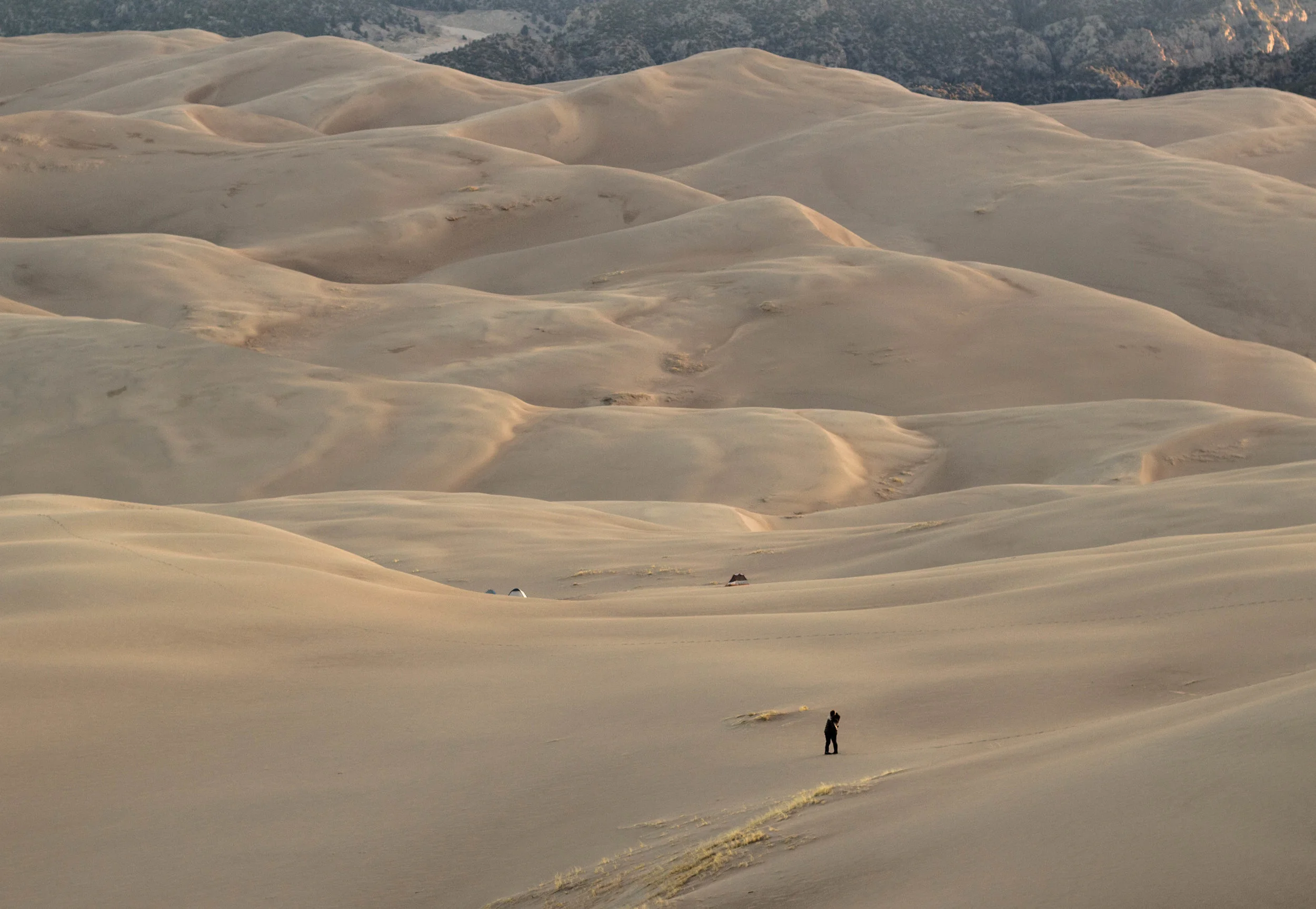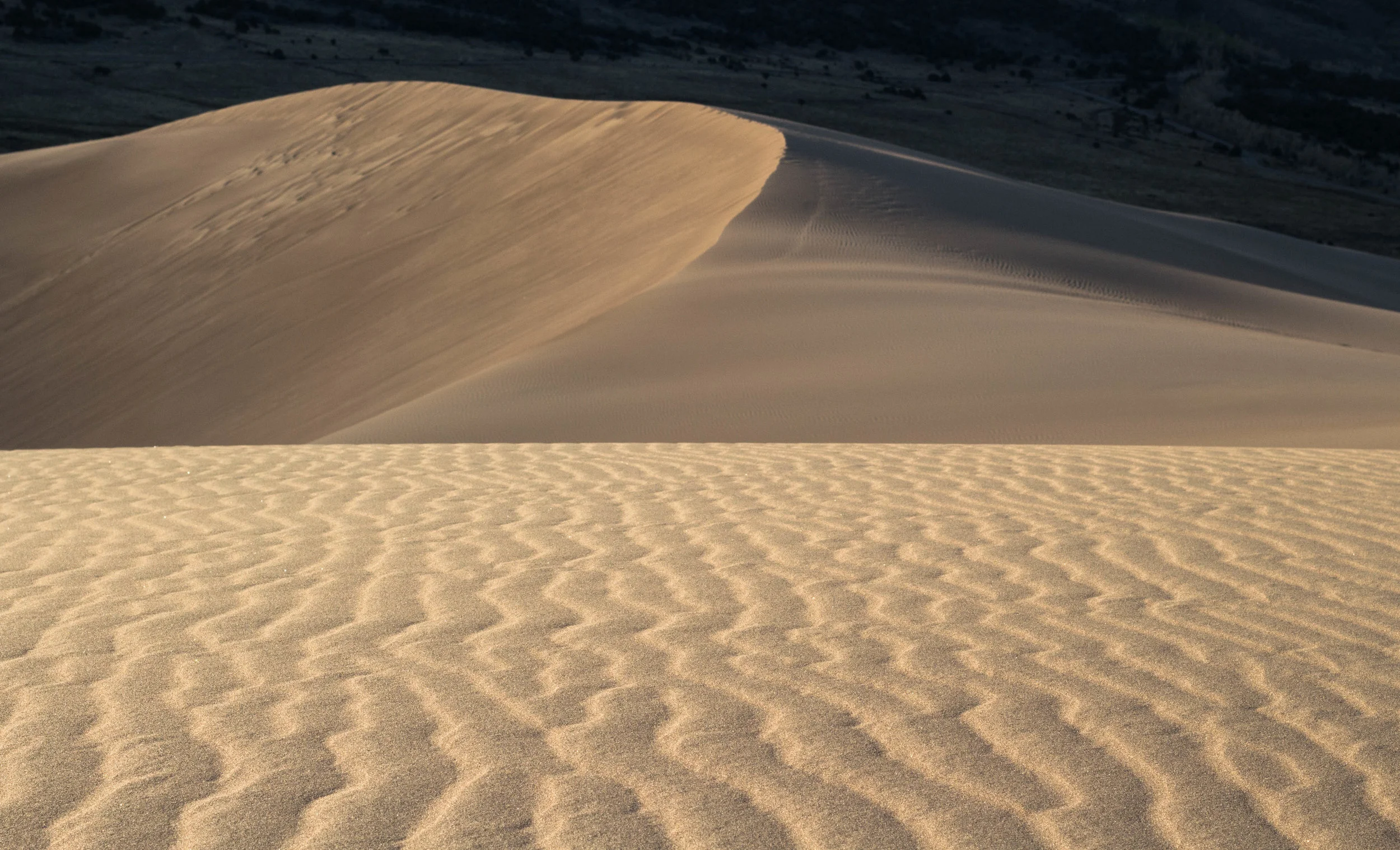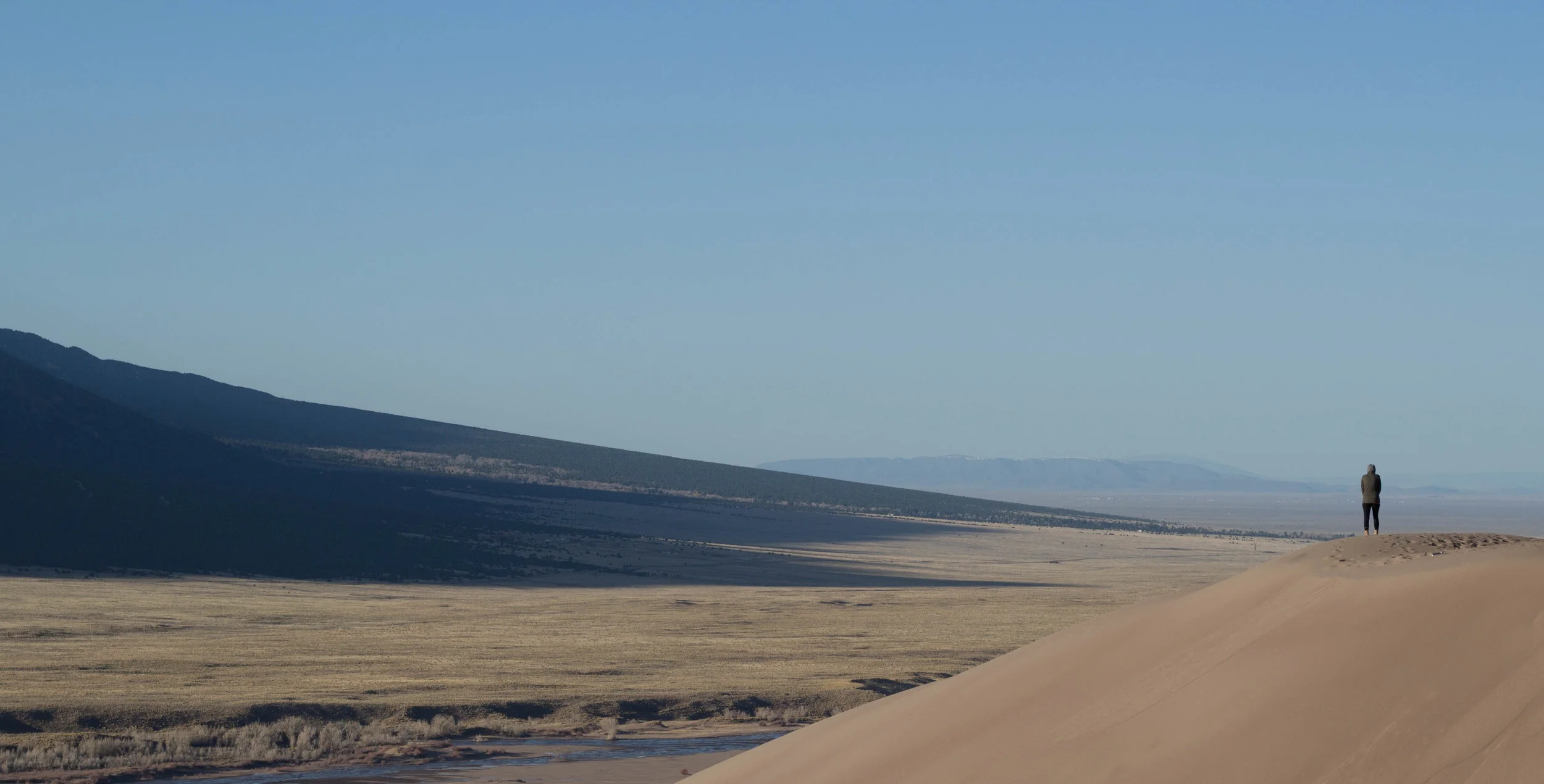Backpacking: Great Sand Dunes National Park & Preserve
The Great Sand Dunes National Park and Preserve is tucked into the Sangre De Cristo mountain range in southern Colorado and features the tallest sand dunes in North America.
The Plan:
Drive down to the Dunes from Denver in the early morning. Get an overnight permit at the Visitor Center, hike up to the summit of High Dune, hike to the summit of Star Dune, then head north until I either (1) get tired or sick of hiking, or (2) find a decent flat area to camp with amazing views of the dunes and mountains. Hike out in the morning either during or after sunrise. Take the long way home to stop and take a dip in Valley View Hot Springs to rinse and relax before the long drive home.
The Permit:
Overnight permits are free and only obtained from the Great Sand Dunes Visitors Center which is open every day year-round except winter holidays and the hours are 9:00a-4:30p Labor Day through Memorial Day Weekend and 8:30a-6:00p Memorial Day Weekend to Labor Day.
The Route:
This is the easy part (sort of). There are no "trails" on the sand dunes. There are only dunes that have more footprints than others. You can go any which way that you like. From the parking lots, High Dune is literally just the highest dune you can see. And from the top of High Dune, the highest peak you can see continuing east is Star Dune. After that, I'm just going to follow the most interesting routes and ridges toward the most unique shapes and lines that I see.
The Trip:
After parking in the designated overnight lot, you'll make the short hike to the base of the dunes which requires crossing the Medano Creek flow. The depth and flow of the creek depends entirely on the melting snow runoff from the neighboring mountains. Both times I have crossed in the early spring months, I have been able to get about halfway across before opting to take off my boots and walk the rest of the way. Make sure you check the creek conditions before visiting, but you can expect to take your shoes off to avoid soaking your shoes and socks.
I had only been to the Great Sand Dunes one other time previously and it happened to be my first hike after ACL/MCL reconstructive knee surgery, and I remember thinking: Wow, this isn't very difficult at all. Well, it turns out that was because it was a wet morning before sunrise and the sand was firm and easy to climb.
Getting started in the dunes mid-afternoon with a 35lbs pack is a totally different story. The trek up to the High Dune summit is short but taxing to say the least. Just follow everyone else and head toward the tallest dune you can spot from the parking lot. You are bound to run into at few steep sections that truly feel like you are hiking up a down-escalator. The sand can be brutal, especially in the hot summer months when it can reach 140-degrees.
Also keep in mind that you are fully exposed for your the entirety of your trip on the dunes. You'll want to cover up with clothes or sunscreen to avoid getting burnt to a crisp out there. I chose to wear high hiking boots, convertible hiking pants to go over my boots, a long sleeve shirt, and a hiking hat. This was both to avoid getting sunburnt as well as to keep the sand out of my boots.
After reaching the summit of High Dune, I headed north rather than making the hike out to Star Dune. From reviewing a topographical map, I knew Star Dune was particularly steep, and I wasn't particularly excited for more steeps. I saw some great untouched ridges and shapes that I wanted to explore and photograph, so I opted to continue my loop and find a cozy place to camp.
The late afternoon was extremely windy and made setting up the tent a real pain. Luckily I had some extra long stakes that I brought specifically for pitching in the sand. They proved invaluable, as they actually stuck pretty well after you pressed them in past about six inches of sand. Honestly, I don't know if I could have pitched my tent without them with the wind as bad as it was.
Sunrise and sunset are the absolute best times in the dunes. The colors and more importantly the shadows are unrivaled. The views change by the minute so if you plan on photographing out there, make sure that you've scouted out your location, have the lens you need on the camera (you do NOT want to be changing lenses in the sand!), and you are ready to shoot!
After some sunset shooting, I ate my dinner and took a nap while waiting for darkness. I knew the half-moon wouldn't rise till just after midnight, so I wanted to shoot in complete darkness, as the dunes are one of the darkest places in the entire country. Let me tell you, the stars did not disappoint. I'm treated to amazing night skies in the Rocky Mountains all the time, but when I woke up from my nap and opened my tent, I was absolutely blown away by how bright the stars were.
By 11:00p, the wind had disappeared completely. You could here a pin drop, and it remained that way all night. It was so quiet and peaceful for the first time all day. I was growing tired of my tent flapping in the wind and the rustling of the plastic bags I was using as sand bags. I just laid down on my back in the sand in amazement of the stars above and enjoyed my first slice of quiet time. This was probably my favorite part of the trip. I find that I rarely do this while camping in the mountains because the ground it muddy, wet, cold and I never have a towel or blanket to lay on. With the sand you can just lie down and quickly brush off the dry sand when you get up.
Out of curiosity (and laziness), I decided I wouldn't bother blowing up my sleeping pad. I wondered if the sand would be cold and would suck the warmth out of me like the ground does when you're camping on land. I had my 0-degree down bag on me so I figured I would give it a shot and sleep directly on the floor of the tent. I gotta say, it was perfectly fine. The lows were in the 30's that night and I stayed plenty warm and comfortable. If I felt a small bump underneath me, I just reached down and patted it down.
I woke up at 5:00a to the brightness of the half-moon on my tent and decided to get up and shoot the dunes under illumination of the moon. It was almost quite literally night and day from when I was shooting earlier in the night. I could see all the dunes surrounding me perfectly and with there still no wind at all, I decided I would pack up and start my hike out as the sun rose. It was the perfect way to start the day and an amazing experience to say the least.
I took the long route home so I could stop and check out the Valley View Hot Springs about an hour north of the sand dunes. Took a quick dip to rinse and relax before the long drive home. Great weekend solo trip all around!
The Love:
Sunrise and sunset shadows
Solitude. Complete and utter solitude
Form fitting sand to sleep on. No sleeping pad needed
Possibly the darkest sky and brightest stars in Colorado
No trails. Simply hike wherever you want and for however long
The Hate:
The wind
No water sources on the dunes
Easier to get lost/turned around
Moving extremely slow due to the sand
Sand get everywhere. I mean, EVERYWHERE
Taking your boots off at the beginning of the hike
The Takeaways:
Camping on sand is totally a love/hate situation. If it's even remotely windy, you're going to get filthy, you're going to be frustrated, and sand will get EVERYWHERE. Even without wind, sand manages to get absolutely everywhere. If you have any camping gear that you care about, LEAVE IT AT HOME! Sand will get in every button, zipper, switch, knob, toggle, and every crevice you can imagine. All that being said, it was an amazing and unique experience and one of the most remote and most comfortable places I have ever camped. If the dunes were closer and I could guarantee the absence of wind, I would do camp out there way more often. But I'll probably save the dunes for day hikes in the future and leave all the gear at home.
The Links
Download my GPS track .gpx file (coming soon)


